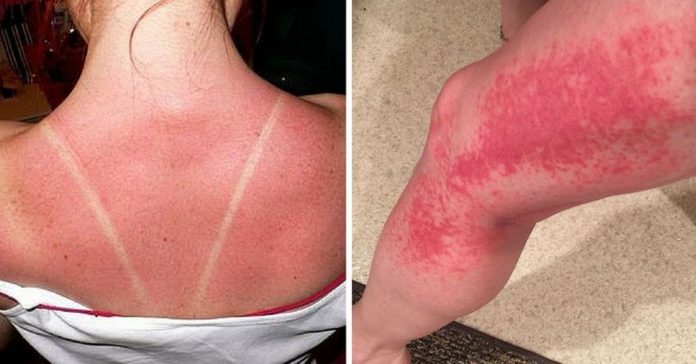There’s nothing wrong with fun in the sun, but carelessness during this hot summer months can lead to sunburns, or worse, sun poisoning.
Sun poisoning refers to even worse damage to the skin that occurs due to excess exposure to UV rays.
It’s not actually poison, but it is very severe and can have detrimental effects on your health.
Here’s what you need to know about sun poisoning.
Symptoms Of Sun Poisoning
1. You’ve Had A Sunburn
Sun poisoning will typically only occur a couple of days after developing a bad sunburn.

2. Dehydration
If you’re developing sun poisoning, you may feel constantly thirsty. You may begin to feel lightheaded due to lack of hydration, and if you don’t do something about it, more serious health issues may follow.
3. Headache and Fatigue
Exposure to UV rays in excess can cause you to feel tired. You may experience lightheadedness or dizziness, which can, in turn, lead to nausea and more severe headaches.
4. Pain and Heated Skin
A normal sunburn mainly hurts when you touch it due to all the inflammation and redness. Even the slightest pressure can feel very painful.
Sun poisoning, on the other hand, causes constant pain or prickling, even when nothing is touching the affected area, and your skin might feel hot.

5. Joint and Muscle Aches
In line with the previous point, sun poisoning can cause pain all over the body, even in areas that don’t necessarily appear sunburned. This can cause joint and muscle pain.
6. Fever or Feverishness
When your body develops a fever, it’s telling you that the immune system is rushing to fix something that’s been thrown off balance. A fever from sun poisoning may also be accompanied by flu-like symptoms.
7. Flu-like Symptoms
Sun poisoning can cause you to develop reactions that are somewhat similar to normal flu symptoms, including headaches and chills. These are often accompanied by a fever or feverishness.

8. Rashes and Blisters
If you’re developing a very bad, large rash on the body or have very painful yellowish blisters forming on your skin on top of the aforementioned symptoms, it’s usually a sure sign of sun poisoning.
Treat the condition before it worsens!
Treating Sun Poisoning At Home
1. Stay Hydrated
It’s important that your body is able to flush out bad bacteria and toxins. In order to facilitate the process, make sure you’re drinking lots of fluids – more than you usually drink.
2. Use A Cold Compress
Wrap some ice or frozen peas in cloth and press it against the affected area for some pain relief. Remember, never place ice directly onto the skin.
3. Cover Burns When Going Outdoors
If you’re leaving the house, make sure all burned areas are covered. This will prevent further sun damage as well as preventing infections.

4. Use Aloe Vera Gel
Aloe vera gel is well known for having cooling properties and working wonders on sunburned skin. You can also use other common cures like oatmeal, apple cider vinegar, or milk.
5. Take Pain Medication
If you’re in a lot of pain, you can take pain meds such as ibuprofen, which also brings down inflammation and can help you recover faster alongside providing relief from the burn.
6. Know When To Call A Doctor
If you’ve been self-treating for a while and your symptoms aren’t going away, speak to a medical professional as soon as possible.
Preventing A Sunburn And Sun Poisoning
1. Use Sunscreen
Never forget to wear sunscreen! Apply liberally and don’t ignore spots like the feet or hands, which are often overlooked when putting on sunscreen and can burn very easily.

2. Keep Yourself Hydrated
You should keep yourself well-hydrated every day no matter what you’re doing, but if you’re going to be under the sun, then you should make doubly sure of this factor.
3. Know When To Duck Out Of The Sun
The afternoon sun is the absolute worst to be in. No matter how protected you think you are, the sun can be pretty fierce around noon onwards.
To be safe, stay out of the sun between 10 o’clock in the morning and 2 o’clock in the afternoon.
4. Use Protective Clothing
Make sure you’re dressed appropriately for the weather. A little style sacrifice can mean averting a big health risk.
Consider using sunglasses, a hat, or even an umbrella if you’ll be out in the heat for most of the day.
























